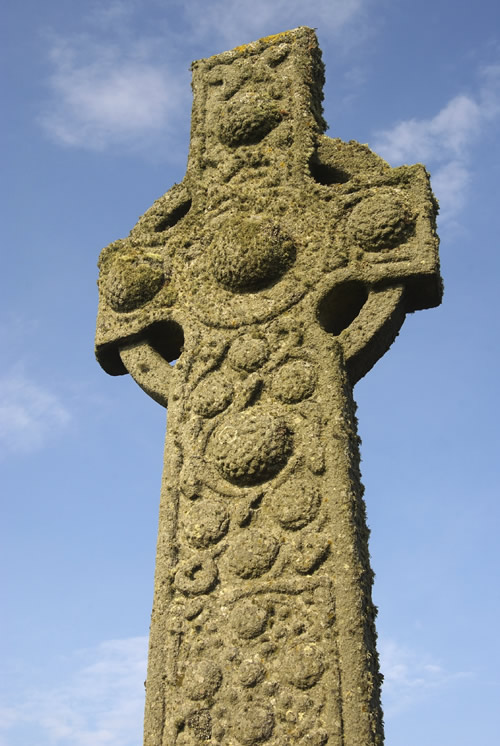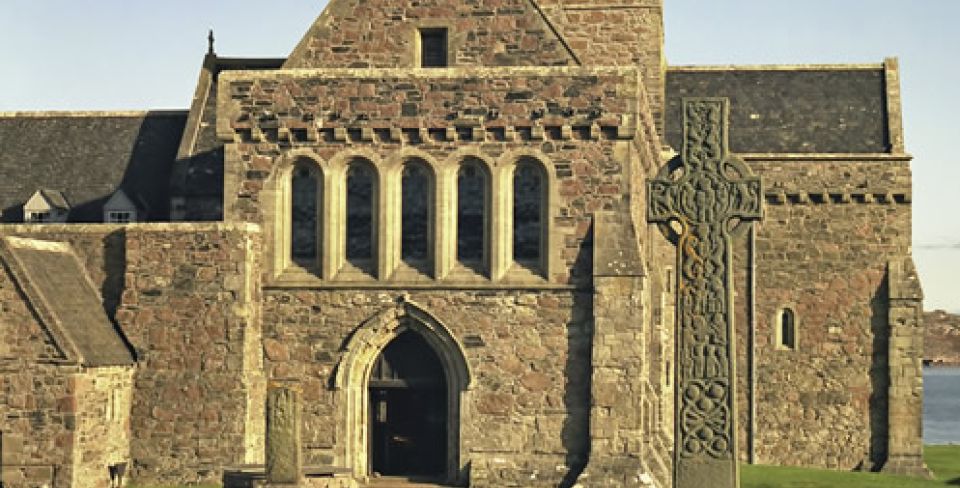7.1 The High Crosses and the Abbey
Colmcille arrived on Iona in 563 having left Derry in Ireland.
According to tradition, Colmcille looked for a place to build his monastery where he would not be able to see his homeland – hence his choice of Iona.
He also needed to find a place where he could live and work in peace. Iona belonged to the ruling Dál Riata who controlled large areas of Argyll and the northeast of Ireland. Conall, king of the Dál Riata, possibly gave Colmcille permission to build his monastery on this land.
Colmcille’s monastery grew to become the centre of a network of religious settlements across Argyll, the outer islands and beyond to Pictland and the northern English monastery at Lindisfarne. This familia of monks and clergy owed their allegiance to Colmcille and the men who succeeded him as Abbot of Iona.
The High Crosses
Outside the Abbey, you can see St Martin’s Cross. There are the remains of four ancient high crosses on Iona, dedicated to St Martin, St Matthew, St John and St Oran.
The crosses may mark the site of the ancient church on Iona and Colmcille’s grave. They were possibly used as markers for pilgrims progressing along the route to Colmcille’s shrine inside the Abbey.
Only St Martin’s Cross – made between 750 and 800 – still stands here complete and on its original site. Nearby is a replica of St John’s Cross. The original St John’s Cross, plus the reconstructed St Oran’s Cross and St Matthew’s Cross, are part of an impressive new display in the Abbey Museum, re-opened in June 2013.
The monks of Iona may have had a particular devotion to St Martin. The saint was a Roman soldier in the 4th century but had a vision of Christ and become a conscientious objector. He became Bishop of Tours but also lived a life of austerity among cave-dwelling hermits. St Martin represented a religious ideal for the monks of Iona – he held an important position in the church while leading a life of poverty and simplicity.
The west face of St Martin’s Cross is decorated with scenes from the Bible including the Virgin and Child, Daniel in the Lions’ Den, David and Goliath, and David with Saul. The east face is decorated with bosses and interwoven serpents, typical decorative symbols of Christian carving of this period.
The popularity of St Martin is reflected in place names all over Scotland – including Kilmartin in mid-Argyll meaning ‘St Martin’s Church’ and the dedication of the 8th century church in Whithorn, Dumfries & Galloway, to the saint.

Tòrr an Aba – Abbot’s Hill
Archaeologists discovered the remains of a small beehive cell on this small hillock known as Tòrr an Aba close to St Martin’s Cross.
This may have been Colmcille’s writing hut, as described by Adomnán,
About a little ink-horn foolishly tipped over.
One day, shouting was heard from the other side of the Sound of Iona. The saint was sitting in his raised wooden hut and heard this, saying:
“The man who is shouting across the Sound is too careless to watch what he is doing. Today he will tip over my little horn and spill the ink.”
His servant Diarmait heard him say this and for a while he stood by the door waiting for the clumsy guest to arrive so that he could keep him away from the ink-horn. But soon he moved away for some other purpose, and then the troublesome visitor arrived. As he went forward to kiss the saint, he upset the horn with the edge of his garment and spilt the ink.
Life of St Columba by Adomnán of Iona, Book I Story 27
Adomnán describes Colmcille as using two separate buildings during his daily life – a writing hut and a hut where he slept ‘where at night instead of straw he had bare rock and stone for a pillow’.
Iona
- 7.1 The High Crosses and the Abbey
Colmcille arrived on Iona in 563 having left Derry in Ireland. According to tradition, Colmcille looked for a place to build his monastery where he would not be able to see his homeland - hence his choice of Iona. He also needed to find a place where he could live and work...
- 7.2 Abbey, Cloister and Vallum
The Vallum marked the boundary of the Colmcille’s monastery on Iona. It is formed by two embankments on either side of a deep ditch. This raised ground is 335 metres long by 152 metres wide. ‘Vallum’ comes from the Latin word for the fortifications of a camp but this was...
- 7.3 St Oran’s Chapel and Graveyard
A cobbled track runs between St Martin's Cross and the wall of the graveyard. This is the only visible portion of 'The Street of the Dead', a medieval pilgrimage route used for funeral processions. St Oran’s Chapel is the oldest ecclesiastical building on Iona, and dates from the 12th century....
- 7.4 The Nunnery/An Eaglais Dhubh
The Nunnery was built at about the same time as the Benedictine Abbey - in the 13th century - by Reginald, son of Somerled, Lord of the Isles. His sister Bethoc was the first prioress. Bethoc followed the Rule of St Augustine. Iona had one of only two Augustinian nunneries...
- 7.5 Martyr’s Bay
Martyrs Bay is just south of the village and pier. The derivation of its name is not certain. If the original name was Port nam Mairtear, it may allude to the slaughter of monks in one of the Norse raids of the 9th century. Or the word ‘mairtear’ may be...
- 7.6 Hill of the Angels
The centre of the island is fertile grazing ground called The Machair - machair meaning a plain or level field. Continue walking south, with the Sound of Iona on your left. The road turns right to lead west across the island. On the left, just before the gate onto the...
- 7.7 St Columba’s Bay
Colmcille arrived in Iona from Argyll in 563 where he had been seeking permission to build a monastery on land belonging to the ruling clan - the Dál Riata. From the Argyll coast, he would have presumably sailed along the south coast of Mull and landed on the south of Iona at...
- 7.8 The Hermit’s Cell
Today all that remains of the Hermit’s Cell is a rough stone foundation of an oval hut which would have been made of timber or turf. An entrance faces southwest to capture the most daylight. As he tells stories from Colmcille’s life, the saint’s biographer Adomnán describes the island...










Bòrd na Gàidhlig
Great Glen House
Leachkin Road
Inverness
Scotland, IV3 8NW
(+44) 01463 225454
colmcille@gaidhlig.scot
Colmcille
Foras na Gaeilge, 2-6 Queen Street
Belfast
Northern Ireland
BT1 6ED
(+44) 028 9089 0970
colmcille@forasnagaeilge.ie
Colmcille
Foras na Gaeilge, An Chrannóg
Na Doirí Beaga
Gaoth Dobhair
Donegal, Ireland. F92 EYT3
(+353) 074 9560113
colmcille@forasnagaeilge.ie


